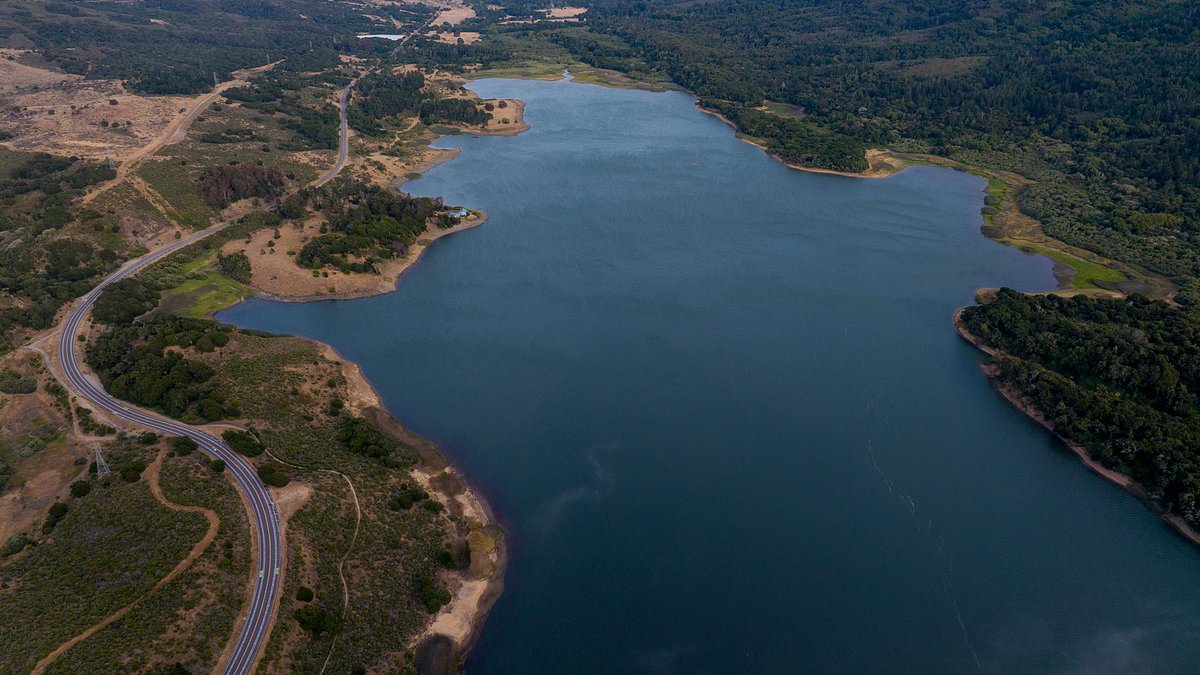On the surface it appears to be just like any other California reservoir, beloved by local hikers.
But the Crystal Springs Reservoir in San Mateo hides a deep secret spanning back centuries.
The basin is nestled within 17.5 miles of hiking trails and plays a crucial part of San Francisco’s water supply system.
Despite its significance in the community, the lake hasn’t always been there.
Far beneath the water level lies an entire town that was engulfed in the late 1800s.
Crystal Springs was submerged to make way for the Lower Crystal Springs Reservoir, which was constructed to address the area’s growing need for safe drinking water.
But before it met its watery end, the town was a bustling resort attracting visitors from miles around.
Situated along Laguna Grande, the area was part of Rancho land, which first hosed non-indigenous settlers when they arrived in the 1850s to 1860s.
By the 1860s, Crystal Springs had become a popular resort village and getaway destination – particularly for San Franciscans, who lived about 30 minutes away from the area.
Stagecoaches regularly brought guests to the town along routes that now align with the modern Sawyer Camp Trail.
Other guests traveled by horseback or hayride to visit the sought-after getaway destination.
By the late 1860s, s in the San Francisco Chronicle popped up, inviting city dwellers to experience the ‘beautiful urban retreat’ of Crystal Springs.
The town featured homes, farms, a post office, a schoolhouse and the Crystal Springs Hotel.
Guests at the hotel enjoyed boating and swimming in the lake, scenic hikes, horseback riding, and dining and dancing at the hotel, which was famous for its wine from the town’s vineyard, planted by California wine pioneer Agoston Haraszthy.
It was the hotel that raised alarm bells in 1874 when, on September 5, they posted a very unusual ‘everything must go’ sale in the San Francisco Chronicle.
The business was sinking… literally.
‘The sale is of everything movable in and out of the hostelry,’ the notice read. ‘Before another winter has passed, the valley in which the hotel is situated, with all its present homesteads, cottages and roads, will be a lake.’
The Spring Valley Water Company began acquiring land in the 1870s to develop a reliable water supply for San Francisco which was facing a crisis.
Water barrels were being transported on the backs of donkeys all the way from Marin County before being ferried across the bay and sold for a fortune.
Engineers and real estate agents searched for solutions in the San Mateo hills. The water monopoly bought soon-to-be-flooded land at deep discounts and the rural dwellers had no say in the decision.
The first dam was built on Pilarcitos Creek in 1867.
In 1875, the Crystal Springs Hotel was demolished to make way for the reservoir, and by 1888–1889, the Lower Crystal Springs Dam was completed, and the town was submerged as the reservoir filled.
Engineer Hermann Schussler pulled off the construction marvel.
It was the first mass concrete gravity dam built in the United States. Upon its completion, it became the largest concrete structure in the world and the country’s tallest dam.
Many buildings were dismantled beforehand, but some structures and remnants were likely left behind and now lie underwater.
Now, the gleaming blue waters of the Crystal Springs Reservoir serve as a major source of San Francisco tap water.
The sprawling lake sees more than 300,000 annual guests who visit the site to walk, bike and bird along the shore.
The dam is the best starting point for a hike, according to Peter Hartlaub of the San Francisco Chronicle.
The Sawyer Camp trailhead starts at 950 Skyline Blvd. near the center of Lower Crystal Springs Reservoir.
‘I’m surprised by the diversity of people out on the trail: elderly couples, families with toddler bikes and shirtless bicyclists and runners getting a competitive-level workout,’ Hartlaub wrote.
The hills are gradual and the paths are wide. This is one of the most accessible parks in the Bay Area.’
